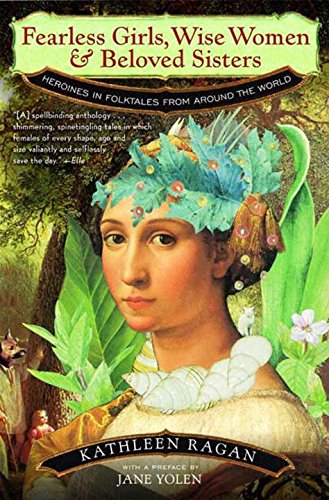Everyone's familiar with the episode where the Prince comes and awakens Sleeping Beauty with a kiss; some people might be aware of older versions of the fairy tale that involve rape and childbirth; sensationalized articles and lists love to use those versions to shock people with the "real" and disturbing versions of classic tales.
While many of the older versions are indeed quite dark and disturbing, they don't all involve rape of an unconscious victim, and True Love's Kiss isn't always the solution in later tales. I used
Surlalune's Sleeping Beauties Tales From Around the World book to gain a few different examples of how the Princess is actually awakened.
Going back to Norse mythology, the story of
Brunhild (from the late late 13th century) is similar to a Sleeping Beauty tale. In it, the bravery of the hero Siegfried allows him to pass through the dangers and get close to Brunhild (although he doesn't actually
do anything, the "vile flames fled in shame and dismay before the pure sunbeam flashes from Greyfell's mane"-so the real secret to heroism is apparently having a magical horse). Once there, he gives Brunhild a
gentle kiss on the forehead (not even the lips) and
softly calls her name, giving us the picture of an absolute gentleman. I find it ironic that this possibly oldest version of the tale is the closest to the Disney in terms of the stereotypical hero riding in on his horse, braving dangers, and saving the day with a kiss. From there we depart from that ideal-
It's the French story of
Troylus and Zelladine from Perceforest, from some time in the 13th or 14th century, that we get to some of the horrific parts of the story. We read a description of how Troylus tries to resist temptation around the beautiful sleeping girl, but just can't help following "the tenets of Venus"-at least this version describes his actions as cowardly, and perhaps tries to justify it a little because Troylus "speaks a long discourse begging forgiveness for his grand liberties." Yet nine months later Zelladine gives
birth to a son, who grabs her finger in an attempt to suckle, and suckles so hard that he
sucks out the sleep thorn that kept her enchanted.
There are other, less well known
Medieval stories which involve a maiden under an enchanted sleep. In almost all of them she is taken advantage of. In
Pandragus et Libanor, the maiden is in an unnatural sleep, does not wake up during the night in question, but simply
wakes up normally the next day. In
Brother of Joy and Sister of Pleasure, the "hero" manages to wake the woman he impregnated with the help of a
bird who gives a magic herb to the maiden. This is one of the rare stories in which the woman actually gets upset to find she has been taken advantage of (Zelladine also felt devastated upon waking)-most sleeping beauties seem strangely silent, even happy, to find themselves awakened with a strange lover and/or child-although in this story she does eventually grow to love her rapist (There are good reasons these stories aren't so well known today). Lastly, in the adventures of
Blandin de Cornoalha the Knight, we find a chivalrous hero who is more like Siegfried-he falls in love but does not appear to succumb to temptation; rather breaks the enchantment through bravery; he learns he must defeat a serpent, obtain a white hawk, and
bring the hawk to the side of the maiden.
Basile's
Sun, Moon, and Talia (early 1600s)
is very similar to "Troylus and Zelladine"-the only difference being that it is
twins who suck the flax from her fingernail and not a single baby. It is this version which also introduces the next violent episode, with the attempted cannibalism of the children. In this version it's a little more understandable, though, because it's the Prince's wife that grows furious when she discovers the truth.
From there we move away from raping/nursing babies as the primary cause of awakening. In
Perrault's 1697 classic version, the prince finds the princess and
kneels at her side (no kiss) just as the 100 years of her curse happen to be ending, so his part in everything is pretty simple. Once the Princess awakes, they simply talk together for four hours, so it's perhaps the best example of love in a Sleeping Beauty tale. The brambles parted to let him through, so while he wasn't quite the brave knight in shining armor, it would have been pretty creepy to continue as the thorns closed again behind him and then again as he walked through the castle where everyone was eerily unconscious, so we'll give him credit for that. The cannibalism episode follows, only now it's the Prince's mother that is an ogress and wants to eat her grandchildren
In the Italian
Sun, Pearl, and Anna, the hero simply
removes a spindle from the grasp of the sleeping Anna. They have children together (followed by the cannibalistic mother in law again) but at least it's consensual; I find this transition (or lack thereof) to be downright humorous: "'How are you today, Anna?' 'Very well, thank you. And how are you, your majesty?' 'I'm well.' By the end of nine months, the girl was great with child."
There's another very brief, tragic Italian tale called
The Son of a King in which the queen mother actually succeeds in cooking and eating her grandchildren and daughter in law (there is no mention of awakening or the princess actually being found asleep in this one, just that she was found in a deserted castle).
In the
Grimm's Briar Rose, once again the hedge parts for our hero (but this time the hedge is filled with corpses from others who attempted to pass before the time was up), and we have a Princess
awakened with a kiss for the first time since Siegfried and Brunhild.
The
Grimms also have another Sleeping Beauty tale,
The Glass Coffin. I thought I had never read it before but it turns out not only had I read it, I
wrote a whole post on it 5 years ago. This is why I have a blog...my memory is terrible! Anyway, it's a fascinating tale in which a Princess was cursed to sleep in a glass coffin because she spurned the advances of an evil magician-she had even attempted to shoot him but the bullet bounced off of him! A traveling tailor discovers her, and all he had to do was
look at her, and she woke up and instructed him on how to open the coffin and free her. Afterwards,
she gave him a "friendly kiss on his lips." This one wins the award for the most active female heroine!
In the Austrian
The Enchanted Sleep, although the count's son does kiss the sleeping maiden, it doesn't appear to awaken her right away. He had also the foresight to
write her a letter, which she later used to summon him to her, and also prove his innocence and his brothers' treachery (they had actually killed him, but animals he had helped along his journey came and healed him).
The Story of
The Prince in Love is from Egypt, but bears similarities to older tales, particularly the cursed flax under the fingernail being what causes the sleep. Here, fortunately, the prince simply
finds and removes the flax, and it's only after she wakes up that he spends forty days and nights with her in bed-although no children result from it. The prince is eventually a jerk to her though, so she decides to teach him a lesson-disguises herself with more beauty and causes him to fall in love with her again, but spurns his gifts, and will only marry him if he
pretends to be dead and is himself carried around in a coffin. I'm not sure shy she wants to marry a man who thinks he's cheating on her, but it is interesting that
he must have his own sort of "enchanted sleep" before they unite.
There's also
The Petrified Mansion from India, in which the prince finds a
stick of gold and just happens to touch the Princess' head with it, which revives her and the rest of the mansion's inhabitants. The curse was brought on by a stick of silver, so gold was the antidote-and the same gold stick later healed the Prince's parents, who were mourning their missing son.
So rather than bravery, many medieval Princes took advantage of sleeping princesses. Later, most Princes became more respectful of the enchanted women, who seemed more likely to be revived by chance than from getting a magical kiss. Some of the tales make us feel uncomfortable to read today, yet some were pretty feminist, featuring strong and brave women, and men who had self control. What other versions of Sleeping Beauty and methods of awakening are there? (I didn't even touch on Snow White tales here...)
Illustrations-A. H. Watson (first two), Millicent Sowerby (last two)



































